Benvenuto to fair Verona, where we lay our scene. Long associated in the minds of literature lovers with romance thanks to Shakespeare’s Romeo and Juliet, this is a city that is filled with seductive charm and understated beauty.
There are few places as romantic for canoodling lovers as St Peter’s Hill, just as the sun is setting over Verona. From this perch, the city glows with a rosy hue as the red roofs light up in the dying rays of the sun. And forget Roman holidays, Audrey Hepburn wouldn’t look out of place pouting over an Aperol Spritz at one of the cafes lining the Piazza delle Erbe.
Of course, Verona has much more to offer than just a picturesque background for honeymooners and lovey-dovey double acts. Some of the most stunning Romanesque architecture in all of Italy is located in Verona, whether you’re marveling at the unique structures of churches like San Zeno and San Fermo or ascending the steps of the Palazzo della Ragione.
Verona, after all, is a city with a good deal of history. It first came to prominence under the Ancient Roman Empire, whose influence continues to remain visible thanks to the remarkable endurance of the 2,000-year-old Verona Arena. Even more of the city’s character today is defined by the civilization that came in its wake, during the ambitious edifices of the Middle Ages and the Renaissance.
It’s true, Verona isn’t as famous as other regions in the Veneto region or neighboring Emilia-Romagna for its cuisine, but that doesn’t mean you won’t find delicious bowls of bigoli pasta on every street corner. Or, perhaps more aptly for summer, little gelaterias with bountiful selections of creamy treats to take the edge off the heat.
For many people, Verona is a bit of an afterthought, but if you peep beyond the city’s low-key rep, there’s a lot more than Shakespeare and Juliet’s balcony to attract visitors seeking the spirit of Italia.
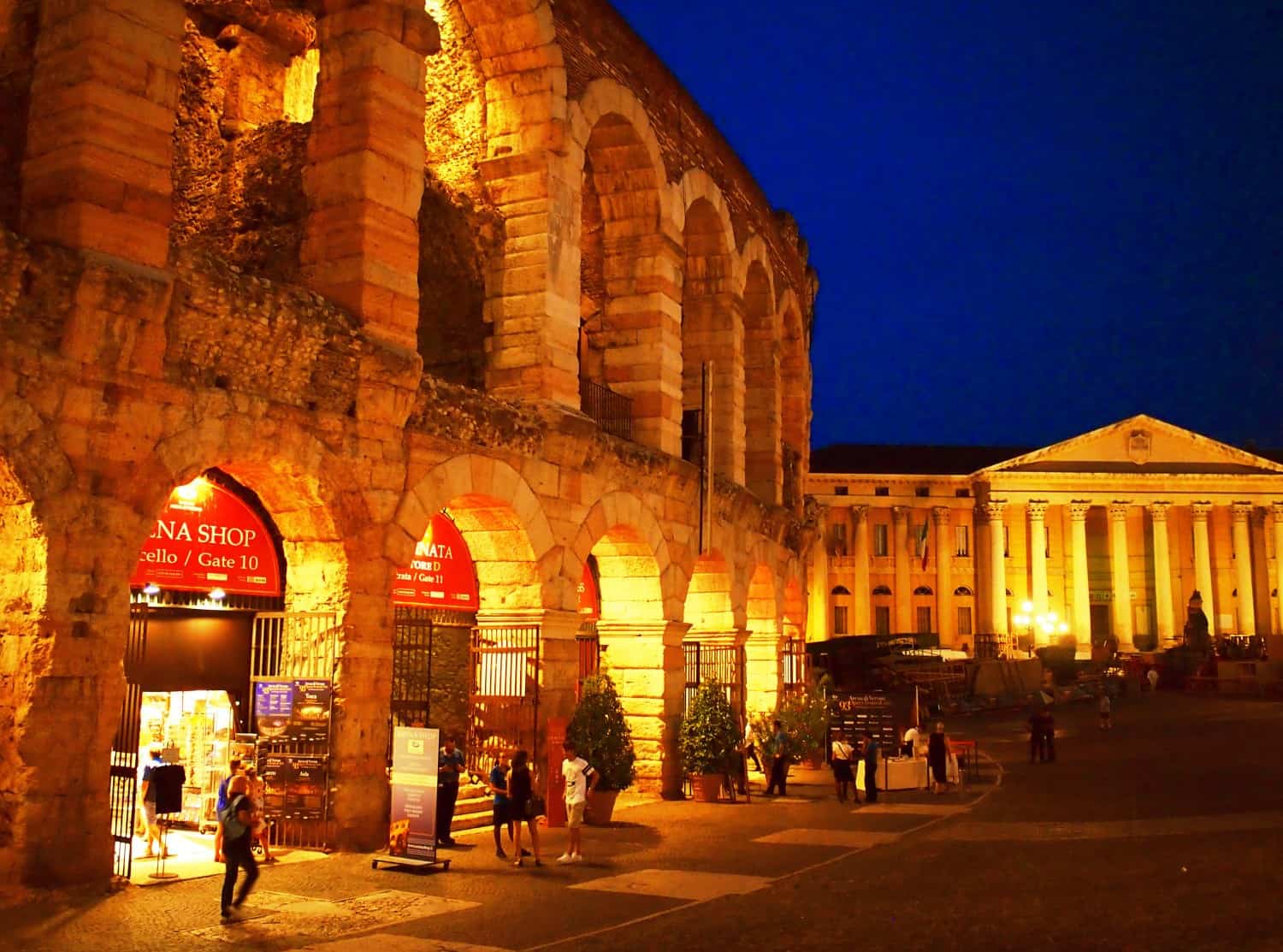
How Many Days to Spend in Verona
Three days is a good amount of time to spend in Verona because it gives you a bit of flexibility. We packed in a lot of sightseeing into two days, in order to have enough time left over to embark on a day trip out of town. For the more leisurely traveler, however, you could easily plan a Verona itinerary that fully occupies three days without leaving the city at all. Just think, even more opportunities to enjoy aperitivo time!
Whatever you decide, you should spend your first day in the historic center of town. The Ancient Romans may have laid the foundations of Verona here, but it is the influence of the Medieval Italians who have really turned the Citta Antica into a gem. Taking your time to examine all the palazzos and architectural secrets surrounding the two major piazzas can easily fill up a whole day, leaving just enough time to explore the city’s greatest remaining Roman monument, the Verona Arena, which lies a short walk outside the old area.
Day two is essentially devoted to exploring everything else that Verona’s downtown area has to offer. This will be a slightly more spread-out route with more walking between sights, but it’s still just 10 minutes between each spot, from the Basilica di San Zeno Maggiore, via Castelvecchio, to Castel San Pietro.
If you’ve been taking it easy, you could spend your last day in Verona exploring parts of the city you didn’t get around to on days one and two. Alternatively, you could plan a day trip out of town. There are a couple of great options nearby, such as visiting the local wine country or hopping on the half-hour train to Vicenza, which is filled with the glorious buildings of seminal architect Andrea Palladio.
Our recommendation, however, is to visit one of Lake Garda’s most beautiful towns, Simiorne, which just so happens to be a short bus ride away from Verona.
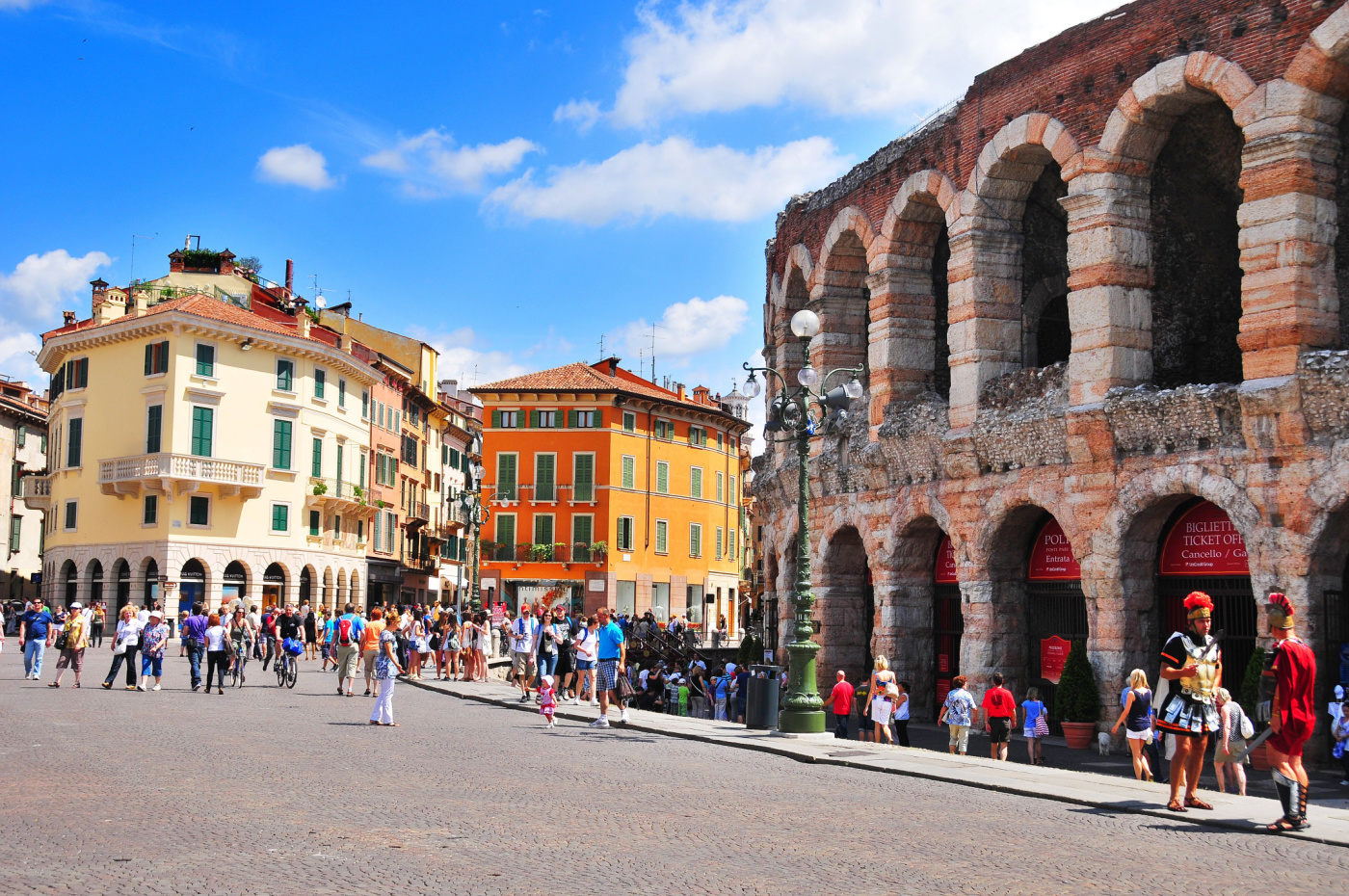
Day One: A Deep Dive into the Citta Antica
Begin your exploration of Verona at the Piazza Bra, the city’s largest square. This open space is overseen by a statue of Victor Emmanuel II, who was crowned as the first king of a unified Italy in 1861. It’s here you’ll find the neoclassical façade of the Palazzo Barbieri (now the town hall), the Palazzo Gran Guardia (now an occasional exhibition space), and – most impressively of all – the Verona Arena.
This ancient masterpiece is one of the best-preserved Roman amphitheaters in the world, despite having had some of its stones pillaged to build a number of Verona’s subsequent Medieval edifices. Completed in 30 AD, it was once able to hold 30,000 spectators, though modern safety constraints now limit its capacity to a more comfortable 15,000.
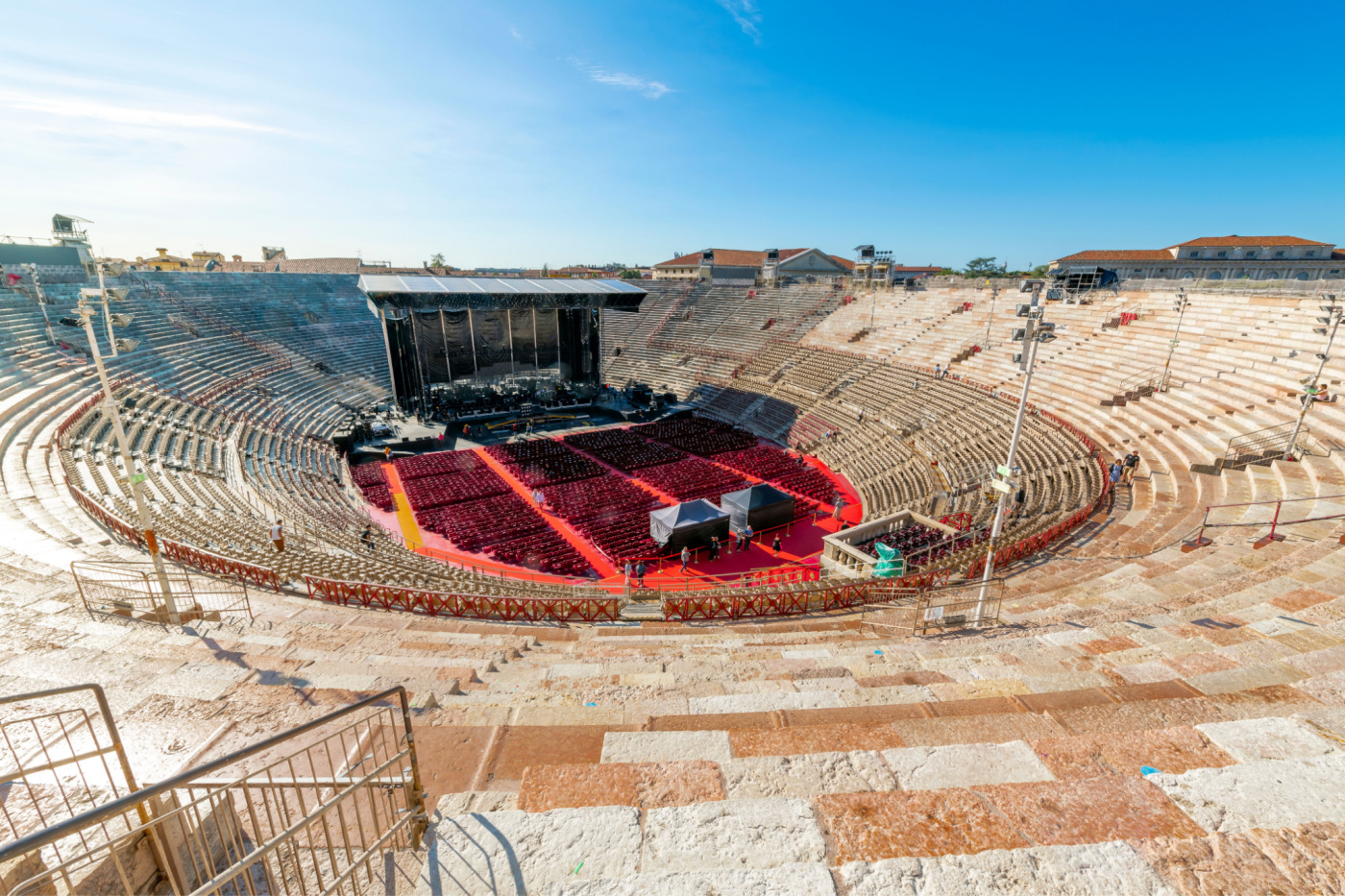
Admittedly, that’s just a fraction of the capacity of Rome’s Colosseum, and nobody could seriously argue that the Verona Arena is quite as grandiose in style as Italy’s most iconic monument. For starters, what you see in Verona is decidedly plainer than Rome’s slightly newer (by a couple of decades) construction. However, unlike the Colosseum, you can clamber all over the different areas of the site, which enables you to get more of a feel for what it must have been like to crowd into the stands as a pleb back in the early 1st century.
In fact, you can still experience a show today in the Verona Arena, albeit not the bloody gladiatorial combat these stone walls once contained. Instead, the venue hosts a rather more genteel form of entertainment: a world-renowned opera festival, which takes place every year during the summer. It’s an experience we heartily recommend, even if you don’t stay for the full show, as there’s no theatrical experience quite like hearing the superhuman voices of the sopranos and tenors echoing off the tiered auditorium. If you just want to opt for a normal visitor ticket, however, bear in mind that during the festival, general admittance to the site is more restricted during the day.
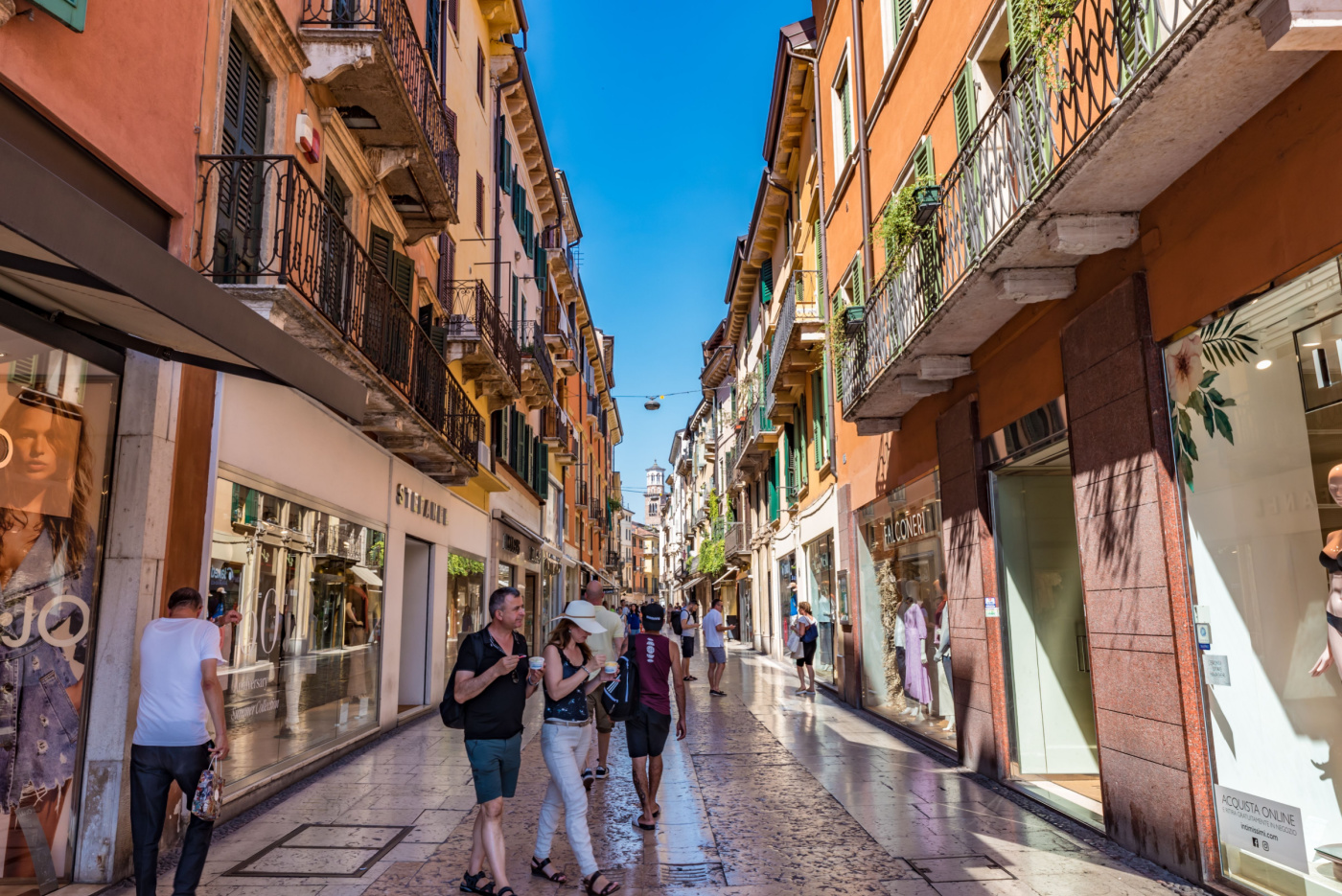
Once you’ve soaked up the ambiance of the amphitheater, head northeast along the Via Mazzini. Considering the narrowness of the street, we were surprised to discover this has become Verona’s premier shopping destination. Nevertheless, today it’s filled with chic boutiques and international luxury brands. You will have to jostle with a mixture of fellow tourists and domestic fashionistas as you make your way along, but it’s worth taking a stroll down the pedestrianized route for some harmless window shopping amid picturesque old buildings.
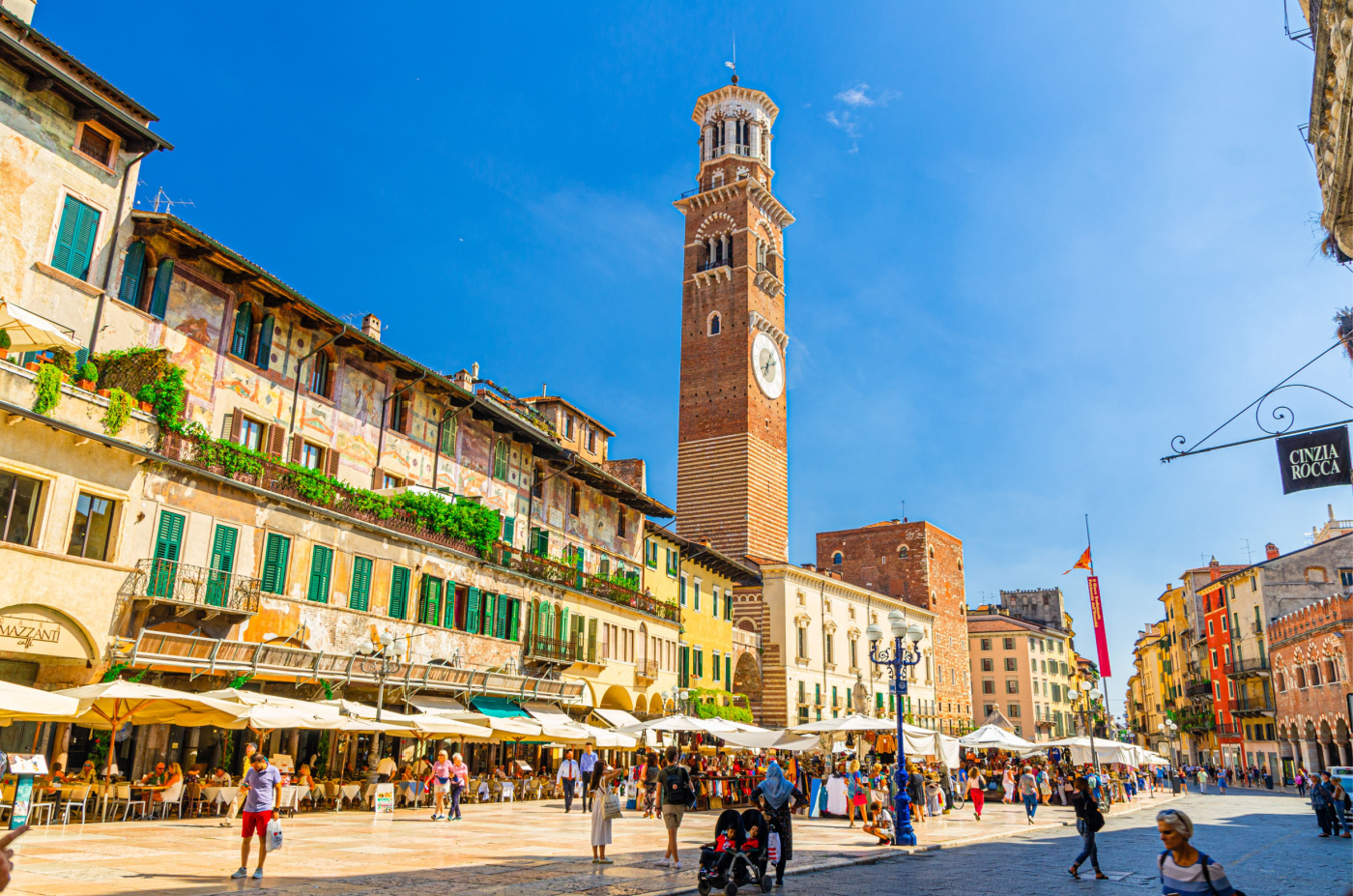
The other benefit of walking along the Via Mazzini is it connects Piazza Bra with the Piazza delle Erbe, the beating heart of Verona’s historic center. Once upon a time, this was the site of a Roman forum, but the current ‘Square of Herbs’ was built more than a millennium later upon the ruins. Take the load off here at one of the many cafes, where you can order a coffee accompanied by a light pastry or a big bowl of bigoli pasta. We were particularly partial to the Aperol Spritz at Caffe Barbarani.
In addition to a fairly standard Italian fountain and a couple of columns, Piazza delle Erbe is blessed with some gorgeous buildings, including the Domus Mercatorum, a striking brick building with restored Medieval mullioned windows and merlons that once housed a merchants’ association. Appropriately, it’s now a bank.
Our personal favorite, however, is the Palazzo Maffei, a Baroque beauty with a showy façade that is summited with statues of the principal Roman gods. Inside, there’s an eclectic art collection spanning the Renaissance to the Modern, but arguably the greatest attraction is the original spiral staircase and other parts of the interior that have been carefully restored to their original grandeur.
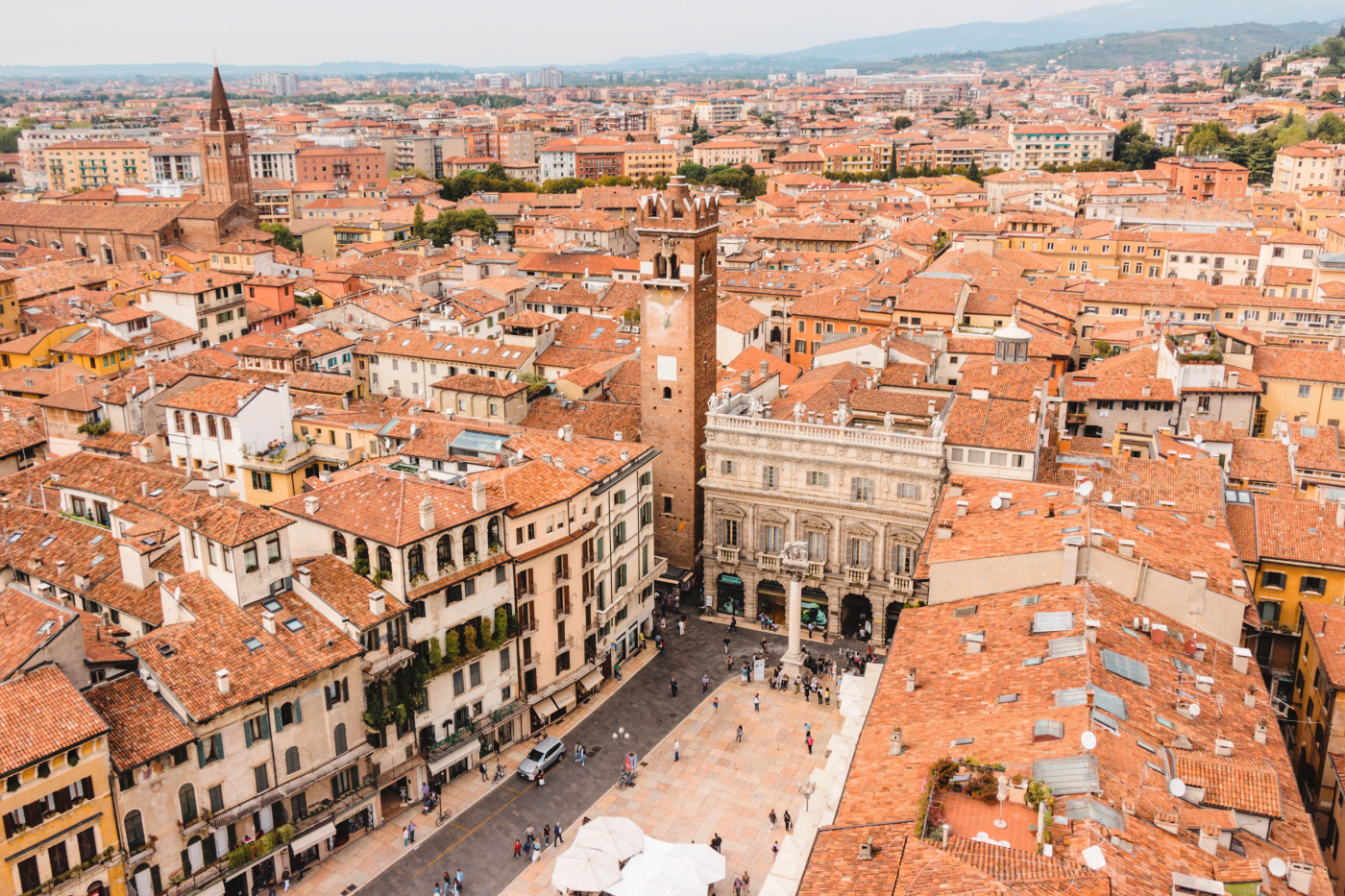
Don’t dilly-dally too long, however, as there’s a lot to see in the Citta Antica! Hovering above the Piazza delle Erbe is the Torre dei Lamberti, Verona’s tallest structure. The tower has an interesting history that begins with its original construction in 1172. After being struck with lighting at the beginning of the 15th century, it was enlarged and topped off with the octagonal marble bell chamber. Finally, in 1779, it was equipped with a clock. Even without knowing this convoluted past, you’ll probably notice that it doesn’t all appear to be of one era, which only adds to its intrigue.
Ascend to the belfry of the Torre dei Lamberti and you’ll be rewarded with panoramic, unobstructed views of the entire cityscape from the relatively modest height of 84 meters. As an added bonus, it’s one of the few towers in Europe we’ve seen that offers a glass elevator as an alternative to the stairs. No need to make those legs work overtime if you don’t have to!
The Torre dei Lamberti forms one corner of the Palazzo della Ragione, a Romanesque palace that now houses a small art collection. The principal reason to visit, however, is not the art but the building itself, including the Renaissance-era Cappella dei Notai (Chapel of the Notaries) with its fabulously frescoed ceilings.
The Palazzo della Ragione is sandwiched between two of Verona’s most important squares: the Piazza delle Erbe, which we’ve already mentioned, and the Piazza dei Signiori (Square of the Gentleman). This latter area is also known as the Piazza de Dante, due to the statue of Italy’s most distinguished poet that has been erected in the center of the space. Around the literary genius are arrayed more beautiful old buildings, several commissioned by the Scaligeri family, who ruled Verona from 1262 to 1387.
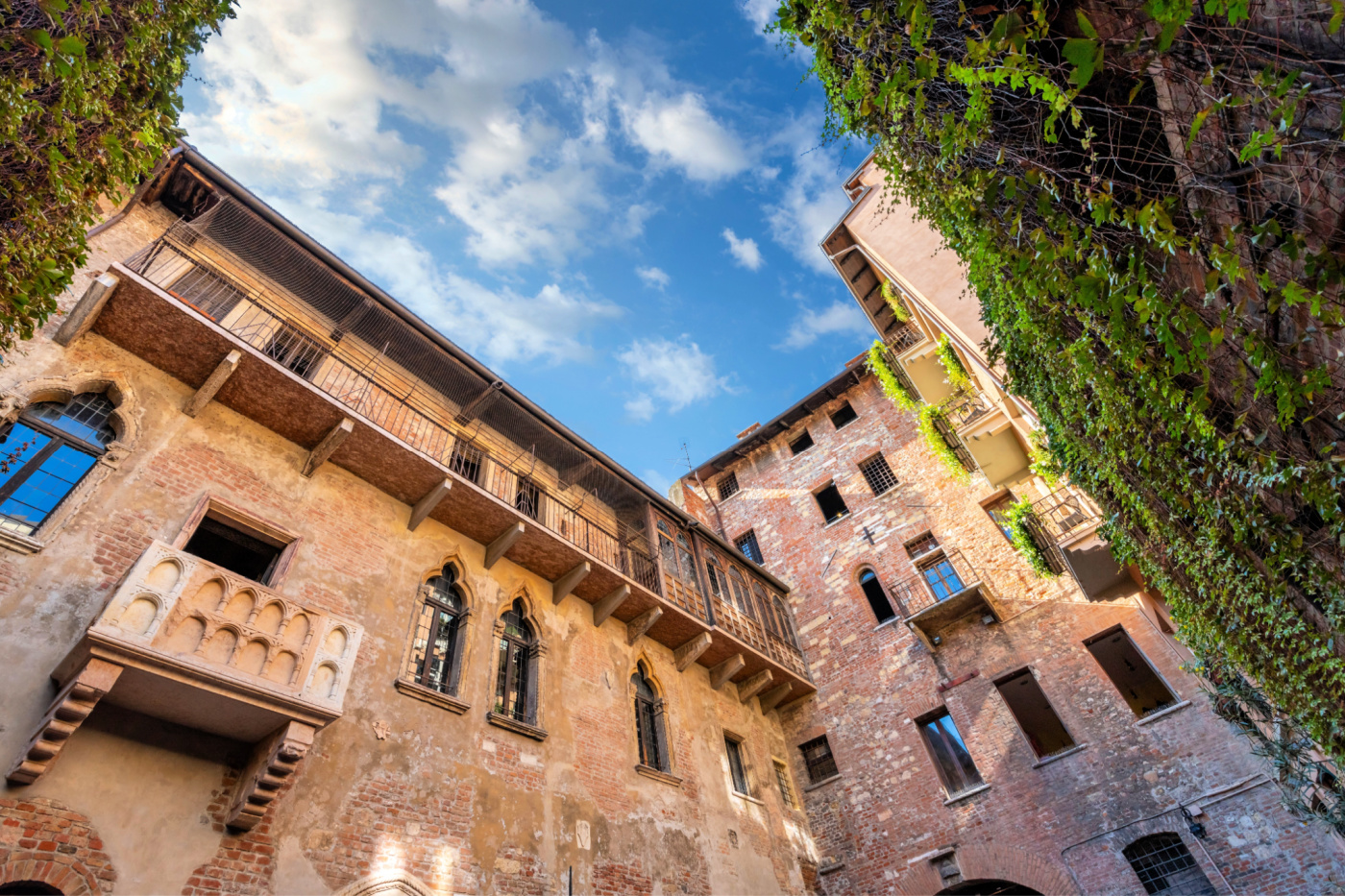
We’re going to briefly mention Juliet’s Balcony, which is a short walk away. Yes, it does sound like a tempting prospect, but the reality is a bit of a nightmare, as people push and shove to fit into a small courtyard. Go only if you really can’t resist the selfie or are a Shakespeare buff who needs to recite Romeo’s speech to feel complete in your life goals. Otherwise, just remember to tell yourself that the balcony was only constructed recently to lure in tourists, and move on with your life.
After reading all this, you might be thinking, wow, there’s a lot to take in and absorb. If it all seems a little overwhelming, it might be worth investing in a professional tour guide to whisk you through the 2,000 years of history. You’ll get a deeper level of detail but also be able to zone out when things become too niche.
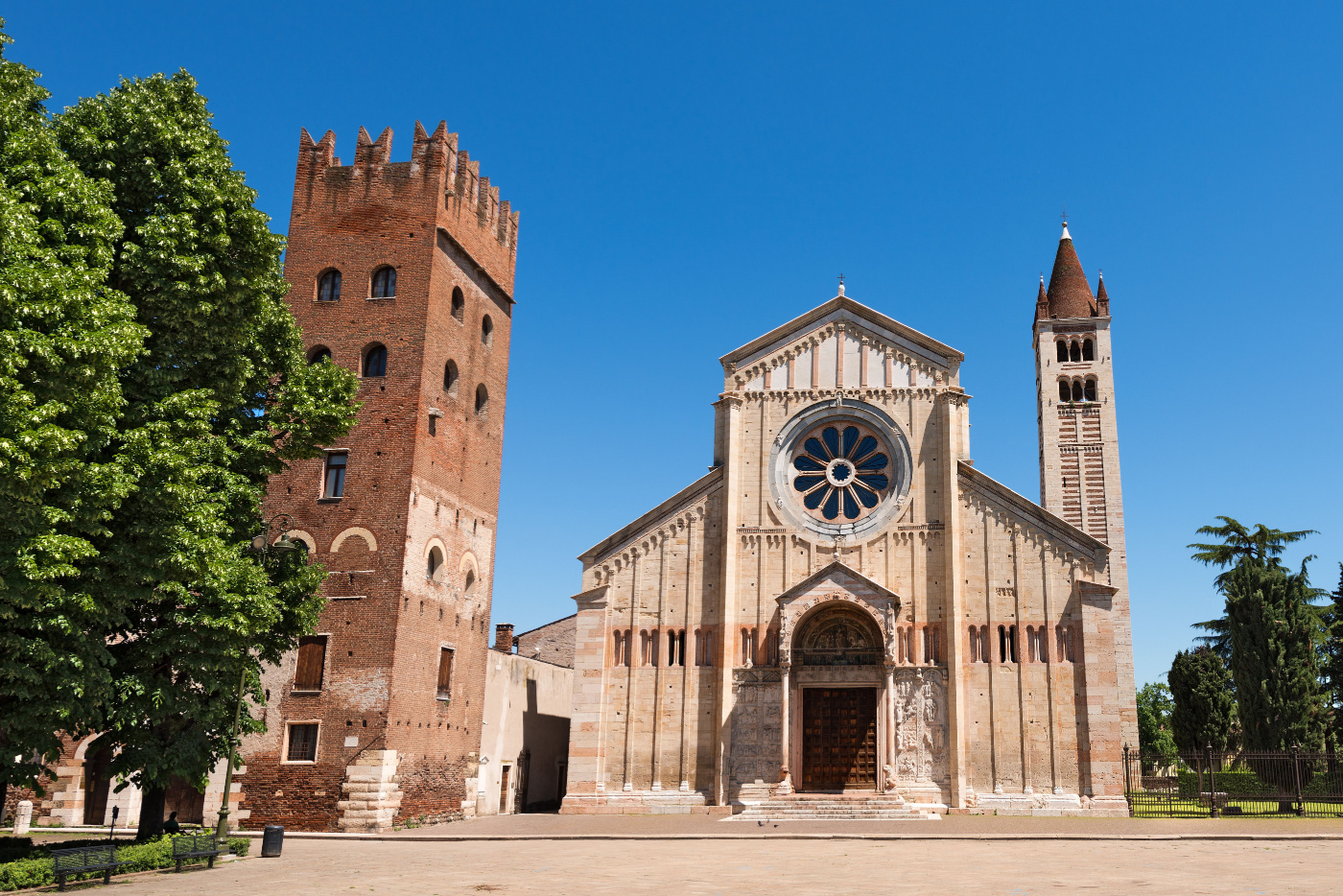
Day Two: Just Around the River Bend
We recommend spending most of day two hugging the banks of the Adige, Italy’s second-longest river after the Po. Kick things off at the Basilica of San Zeno, a church dedicated to Verona’s patron saint. Note that if you are going to follow this itinerary, it’s worth getting a joint ticket for all four of Verona’s most important religious edifices (San Zeno, Verona Cathedral Complex, Sant’Anastasia, and San Fermo), as this is cheaper than paying individual entry.
The Romanesque façade of San Zeno, topped with a rose window, looks understated from afar, but it’s actually got tons of rich detail, including the fabulous sculptures around the porticoed main entrance. Behind the outer doors, the inner doors are mounted with a series of intricately made bronze plates that we spent a good 20 minutes examining (with the aid of the phone camera zoom function to see some of the higher-up ones).
The brick-and-stone stripes of the exterior continue into the interior, which has an unusual structure across three levels. From the main floor with its wooden ceiling painted with stars, you can descend to the chilly crypt, which as local folklore has it, is where Romeo and Juliet were married. If they ever existed. Which they probably didn’t. Anyway, it makes for a good yarn.
Above the crypt on the upper floor is the altar space, decorated with a restored polyptych by master painter Mantegna.
The Basilica of San Zeno doesn’t necessarily impress with size, but it definitely wows with the incredible layers of detail. Before leaving, make sure you set aside a moment for contemplation in the pretty cloisters outside, which are bursting with blooms in the early summer season.
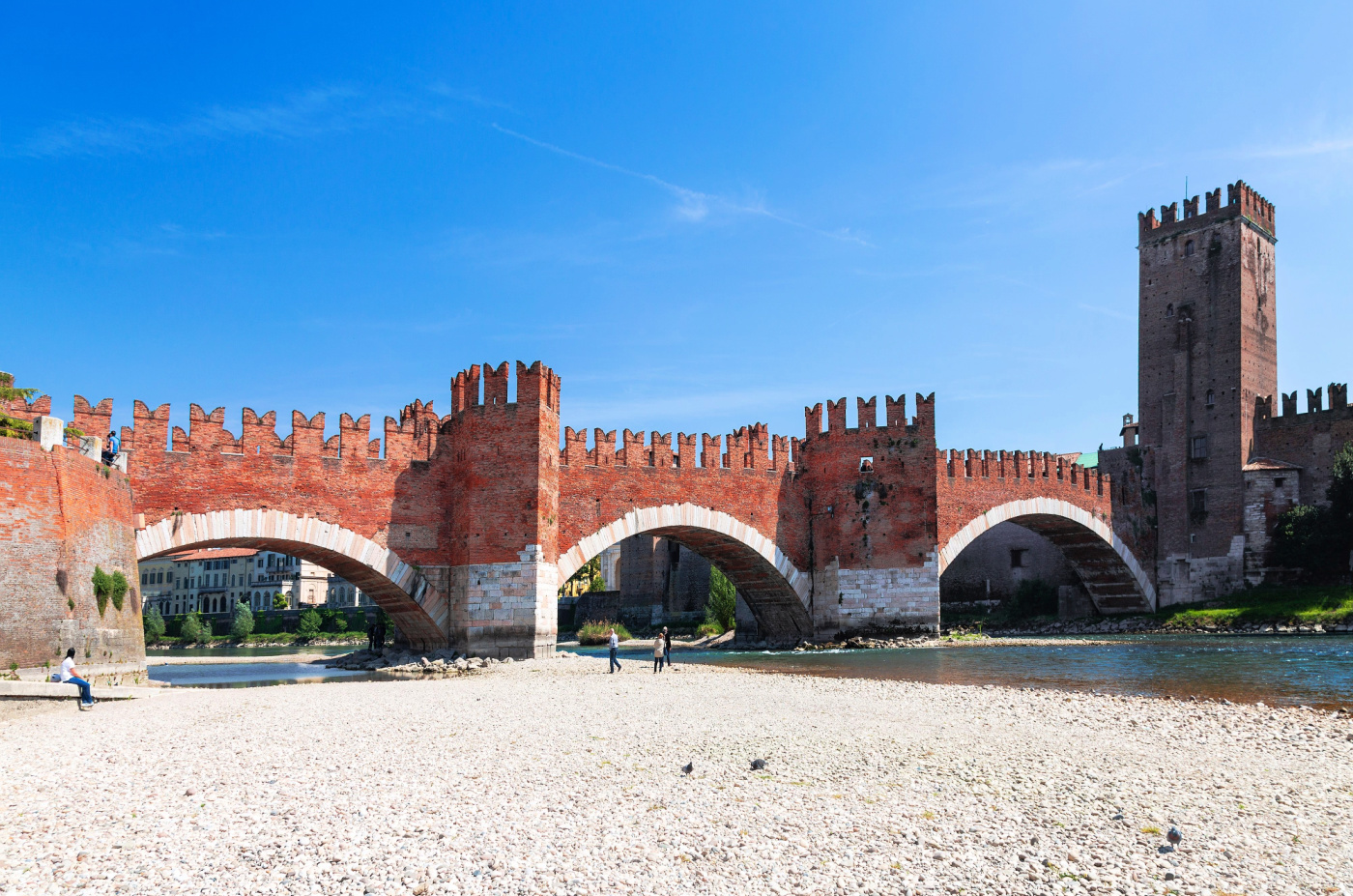
Head towards the River Adige and stroll east along the tree-lined walkway. You’ll immediately see the bright red bricks of the Ponte Scaligero, built by (you guessed it) the Scaligeri family. Aside from the Verona Arena, this is probably the most striking structure the city has to offer. Originally erected in the mid-14th century by Cangrande II, it was designed to act as a sneaky escape route from the nearby castle, Castelvecchio, in the event of a revolt. You may notice that it looks remarkably well preserved, which is down to the fact it was blown up by German troops during World War II but rebuilt soon after.
We highly recommend grabbing a sandwich stuffed with local meats and cheese from Focacceria La Figaccia, then heading onto the Ponte Scaligero to devour it atop the ramparts. If you want your Veronese trip immortalized, there’s usually a portrait artist here eagerly plying his trade.
Once you’ve finished your focaccia, head inside Castelvecchio, which houses a so-so museum that’s worth paying to enter just so you can get into the castle courtyard and up onto the battlements.
Keep heading along the Adige and past the marble Arco dei Gavi, a rather insignificant, reconstructed Roman arch. Pop your head briefly into the Basilica di San Lorenzo, which has another fantastically striped Romanesque interior and seems to be often overlooked (mistakenly, in our opinion).
You’ll know you’ve once more reached the historic center of Verona after you pass beneath the magnificent Porta Borsari. This tiered gate once formed part of the Roman walls that enclosed the Citta Antica and is now pretty much all that’s left of the former defensive structure.
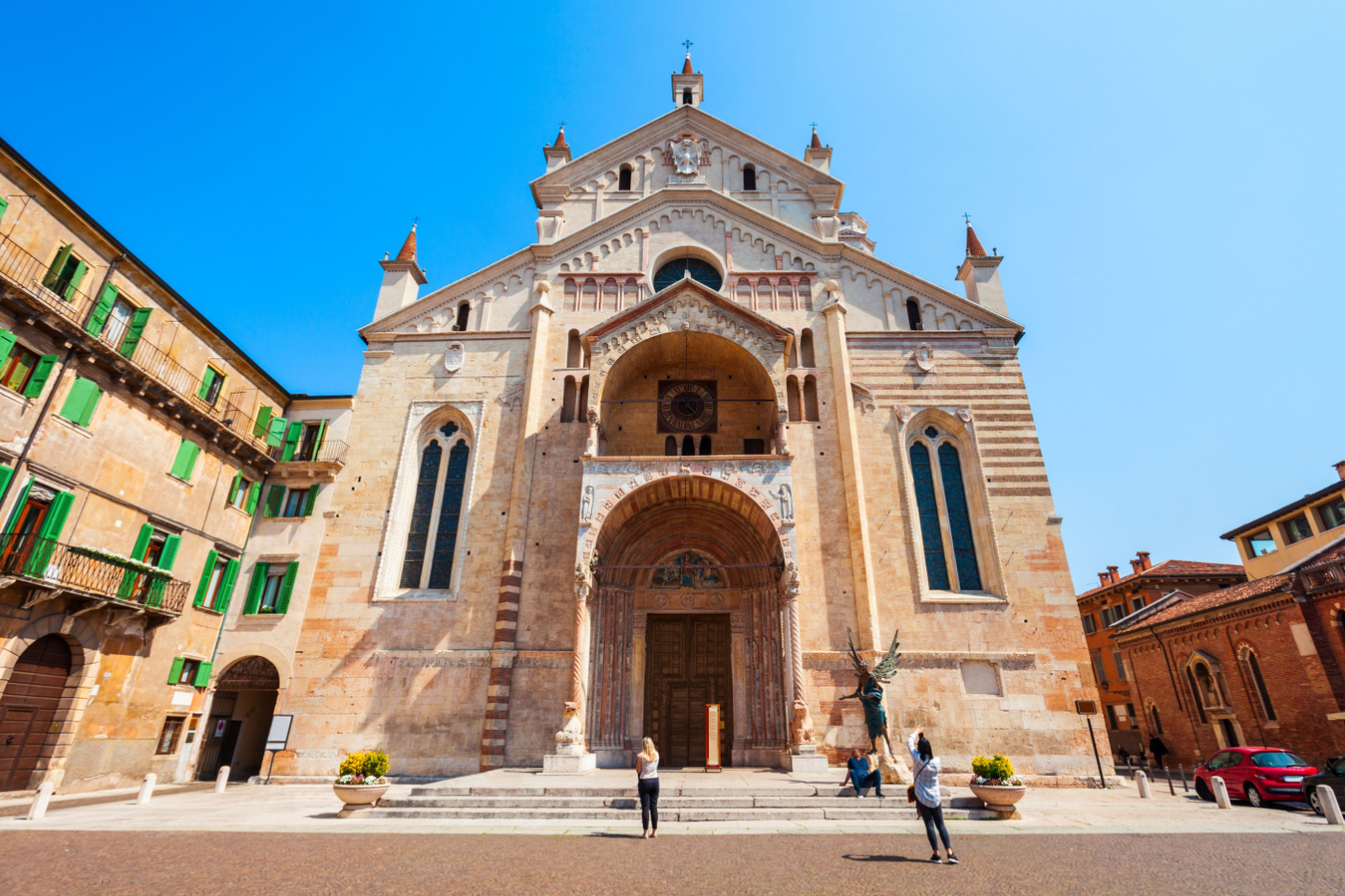
Continue your tour of the city’s religious institutions with a visit to Verona Cathedral. Believe us when we say that by the end of this trip, you’ll be an expert in Romanesque architecture, as the exterior of this building is another beautiful example of the style. The deceptive simplicity of the outside gives way to red Veronese marble, black-and-white checkered floors, and an ostentatious pillared choir screen, which is arguably the most unique part of the building.
A city’s cathedral is often easily the highlight when it comes to its religious edifices. Not so in Verona, which has a splendid array of smaller, more unique churches that really enchanted us. Sant’Anastasia is one of these. The frontal façade is actually rather uninteresting, though on other sides you can see several extensions that speak to the steady accretion of chapels through the years. Inside, the ceilings are covered in garlands of floral paintings designed to complement the red Veronese marble of the floor.
At this point, you’ll probably want a break from the religious architecture, even if it is absolutely fantastic. So head across the Ponte Pietro (St. Peter’s Bridge) to the foot of Colle San Pietro (St. Peter’s Hill). Now you’re faced with a choice: whether ‘tis nobler in the mind to suffer the slings and arrows of having to climb the hill on foot (sorry, another Shakespeare reference) OR if you’re just going to cop out and take the funicular up the top – admittedly a pretty fun alternative. Either way, you’ll end up at the castle that commands the high ground.
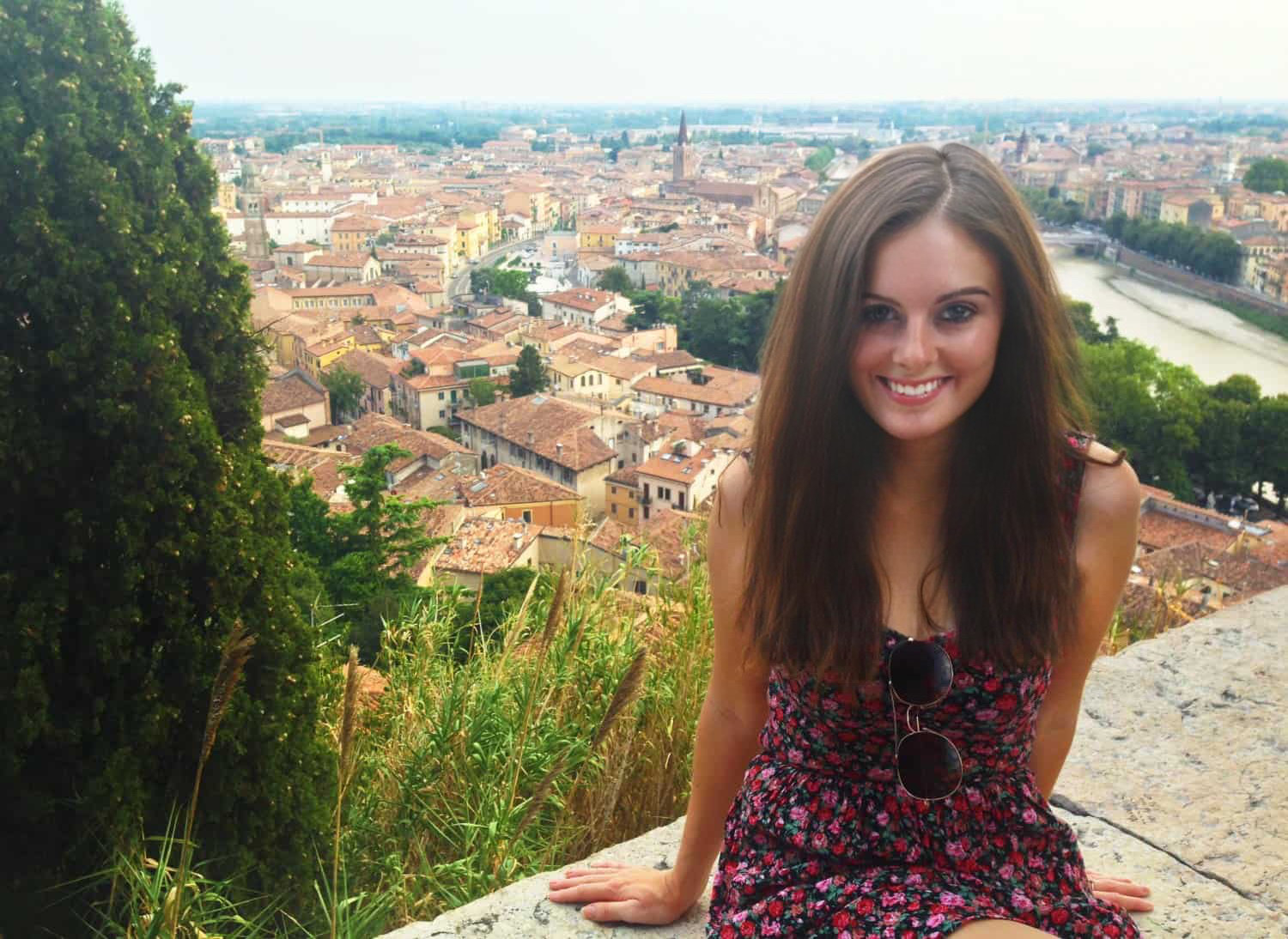
As with so much in Verona, the Ancient Romans set the trend by building a fortress here a long time back. Several hundred years on (and a few destroyed buildings later), the current castle was built in the mid-1800s.
Before you get too excited, the castle itself is out of bounds due to structural issues. The point of making the ascent is for the sweeping views of Verona and its uniform array of terracotta-colored roof tiles. In our opinion, this is the best place to see the city in all its glory. If you’re feeling peckish, Re Teodorico serves up some pretty good pizzas – admittedly at some punchy prices, but hey, you’re paying for a gorgeous view from the terrace.
Back at the bottom of the hill, you can visit a Roman theater with an attached museum containing an assortment of ancient artifacts, like sculptures and mosaics. At the risk of being overly dismissive, the theater is mightily underwhelming after the arena, and you can see better exhibits of antiquities in Rome or (even better) Naples.
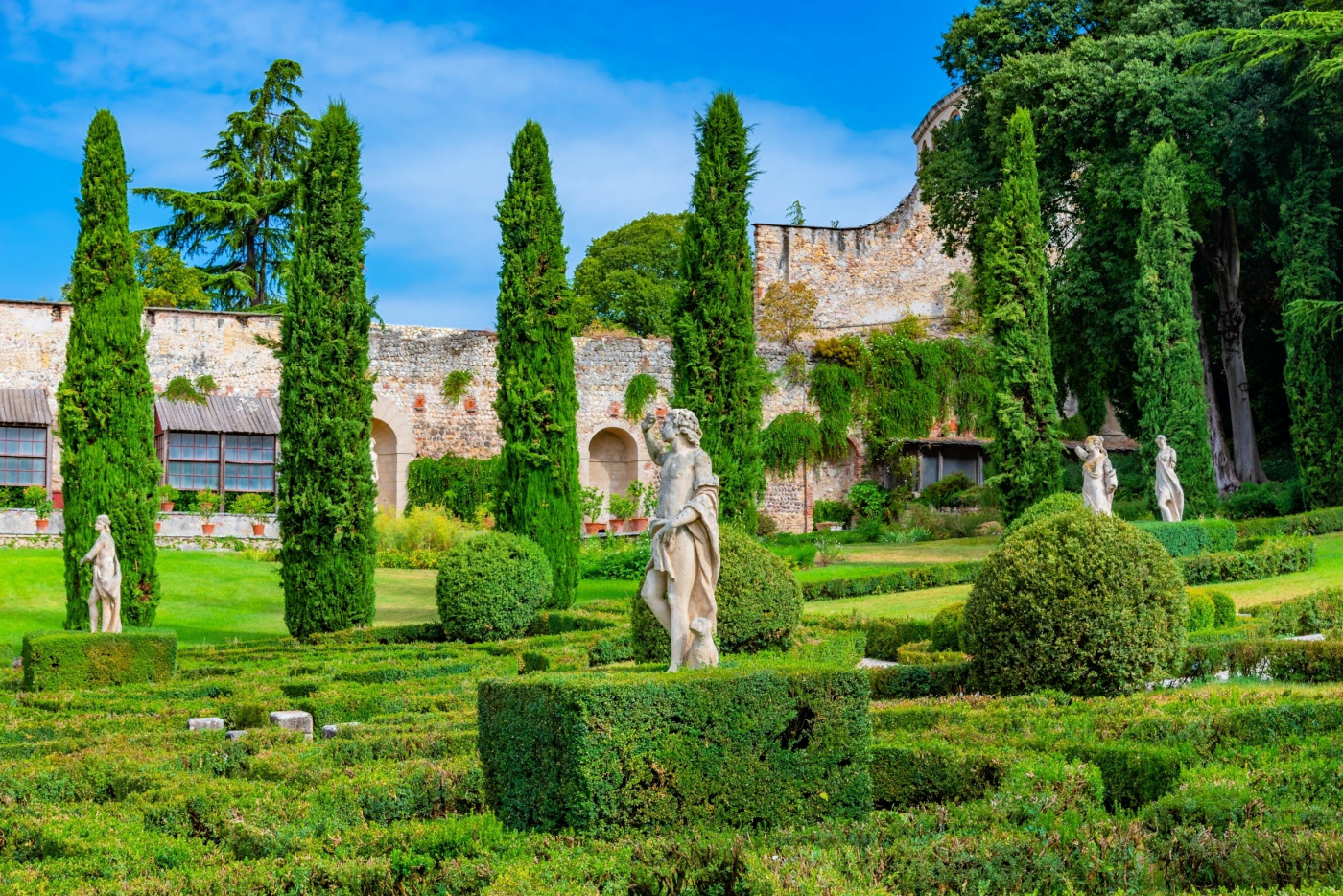
Take our advice and skip it in favor of the Giardino Giusti, a 16th-century garden designed along classic Italian lines. Few places give such a concrete idea of the overall schema favored by horticulturists of the period, which is what makes the overall experience of wandering along the cypress-lined avenues and through parterres so interesting. Part of the palazzo that accompanies the gardens is also open to the public, displaying the fabulous luxury of the early 20th-century lifestyle available to well-to-do Italians.
Cross back across the Adige via the Ponte Navi for the last church (and final stop) of the day, San Fermo Maggiore. The uniqueness of this spot lies in the fact that it is actually two churches built one on top of the other. The lower church is the older section, with wonderfully preserved frescoes from the 12th and 13th centuries. The upper church is a far grander affair of marble sculpture, extensive tempera paintings, and a stunning wooden ceiling.
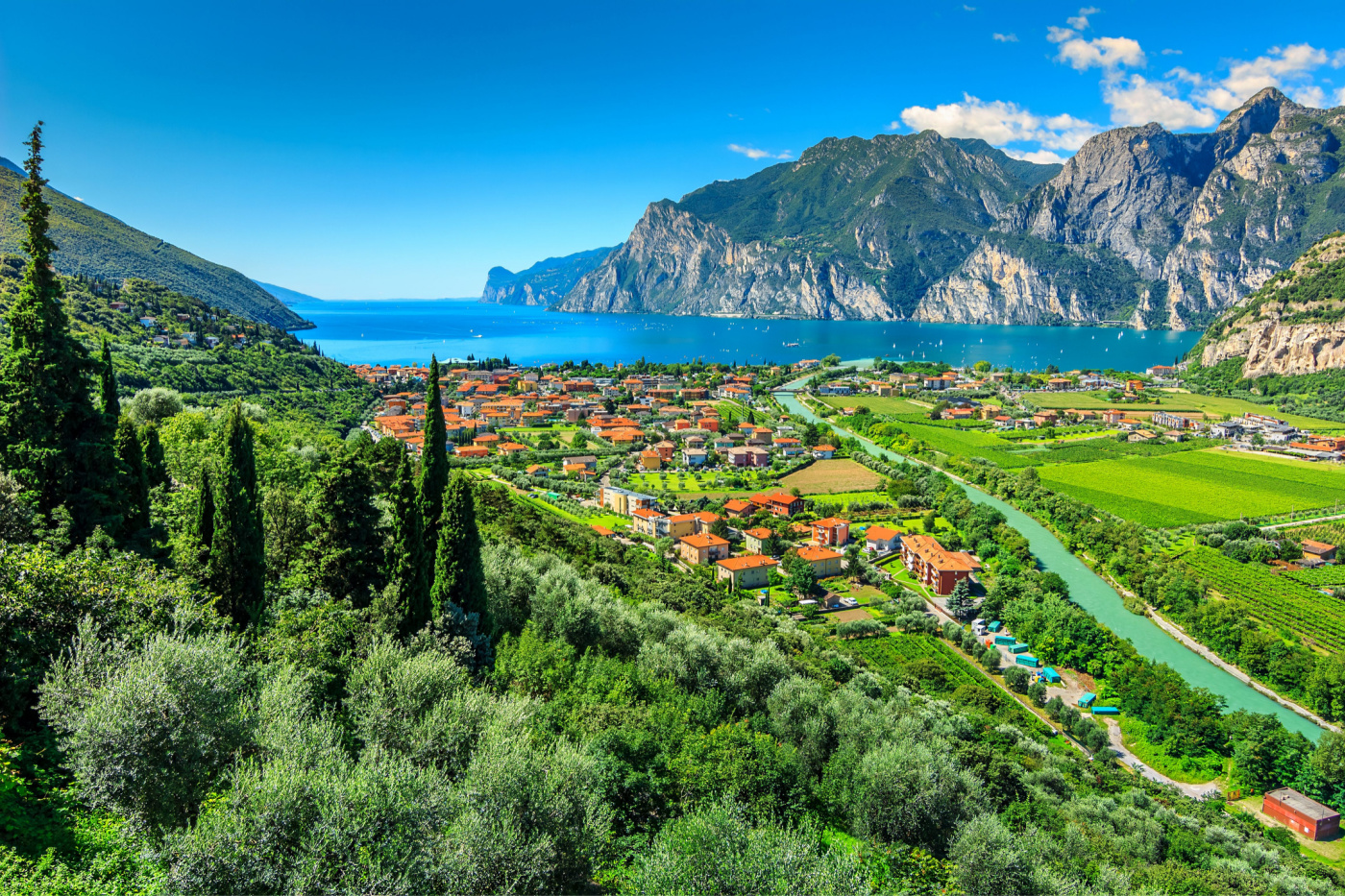
Day Three: Lake Garda’s Prettiest Town
Lake Garda is where Italians go to escape the heat of the city. After two days of plodding the streets of Verona, it’s a fantastic place to cool off if with a refreshing bit of country air.
There are several lovely little towns lining Lake Garda’s shores, and you can be sure that every local you meet will have their own favorites that they will vociferously vouch for. In terms of combining beauty and convenience from Verona, Sirmione is our pick of the lot, even if it is incredibly popular during the summer season.
Several tour companies will take you from Verona to Sirmione and arrange for a boat ride onto the azure waters. However, it’s also very easy to make it there yourself using public transport. We caught a direct bus from beside the Verona Arena that took just under an hour to get us to Colombare. It’s then a 20-minute walk, past a series of hotels and car parks, to reach the town proper.
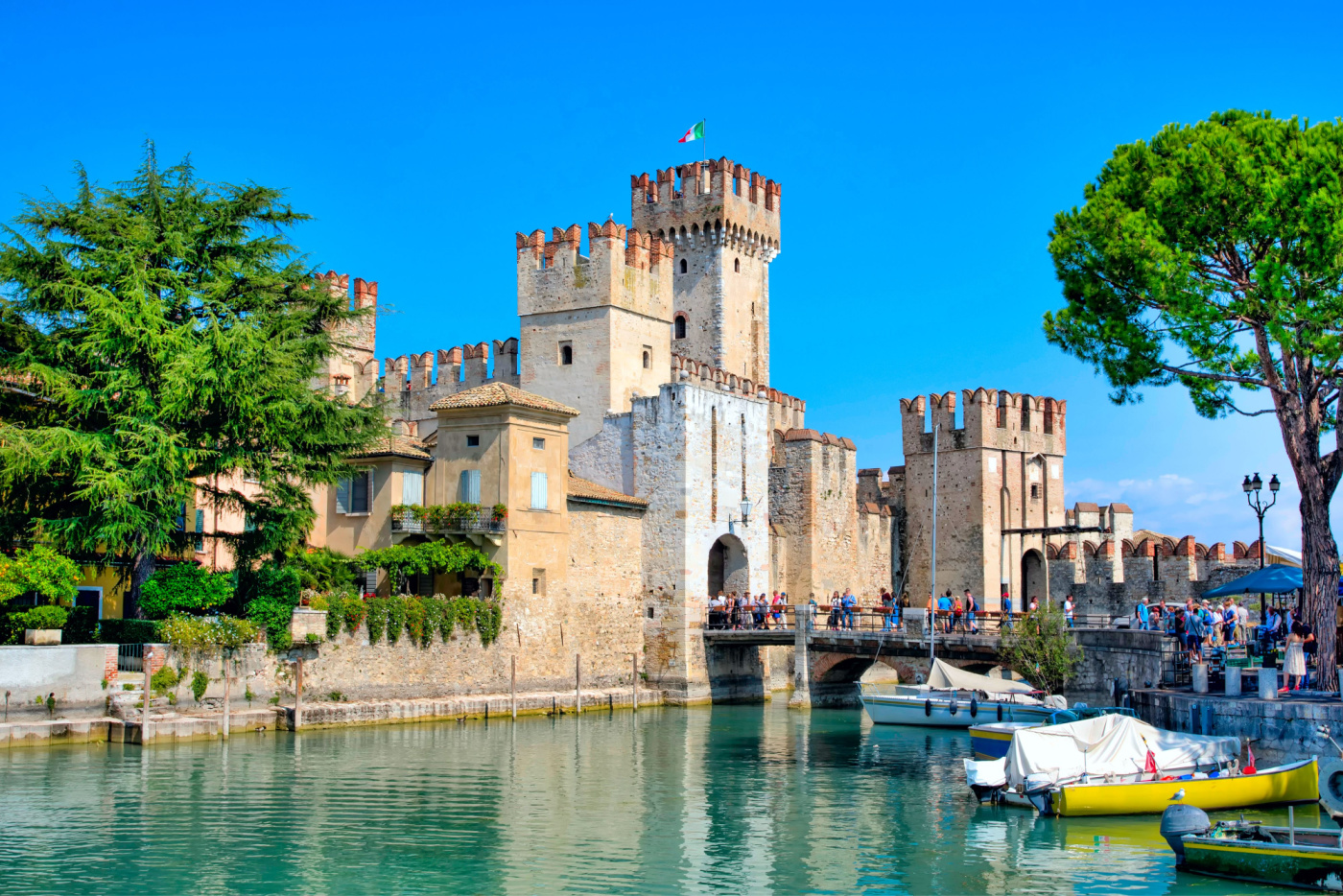
Sirmione is uniquely situated on a narrow spit of land that juts out into Lake Garda. Entrance to the town is guarded by the Scaligero Castle, another construction project of Verona’s former first family. Clambering up onto the ramparts gives you wonderful views out onto Sirmione, as well as a glimpse at one of the few fortified ports from the Medieval era that still survives today. Legend has it the ghost of a former resident haunts its halls, searching for his murdered wife, but the scariest thing we saw was a very fat bird.
We would say feel free to get lost amidst the adorable narrow streets and houses, but realistically the town is so small you won’t be able to lose your way even if you try. As with most places popular with the tourist crowd, the majority of the buildings here are now restaurants and shops. Grab a scoop of gelato or a colorful ice lolly from Cremeria Bulian and take your time perusing the streets.
Another experience you can try in Sirmione is to take a plunge in the thermal baths. We haven’t done this ourselves – Garda was right there! – but if this piques your interest, there are several pools that claim to rejuvenate the skin through the sulfurous waters that rise up from the depths of the lake.
At the very end of the Sirmione peninsula is the Grotte di Catullo, the ruins of what was once a grand villa. It’s a fabulous location, even if the bits of masonry that remain aren’t all that impressive. From this vantage point, you’ll see Sirmione’s famous Jamaica Beach, so named because the waters here are said to be as beautiful as those found in the Caribbean. We’re not sure about that, but it’s certainly a picturesque bathing spot. Snag a spot on the rocks that abut the waters and enjoy a refreshing paddle to bring your Veronese vacation to a soothing close.
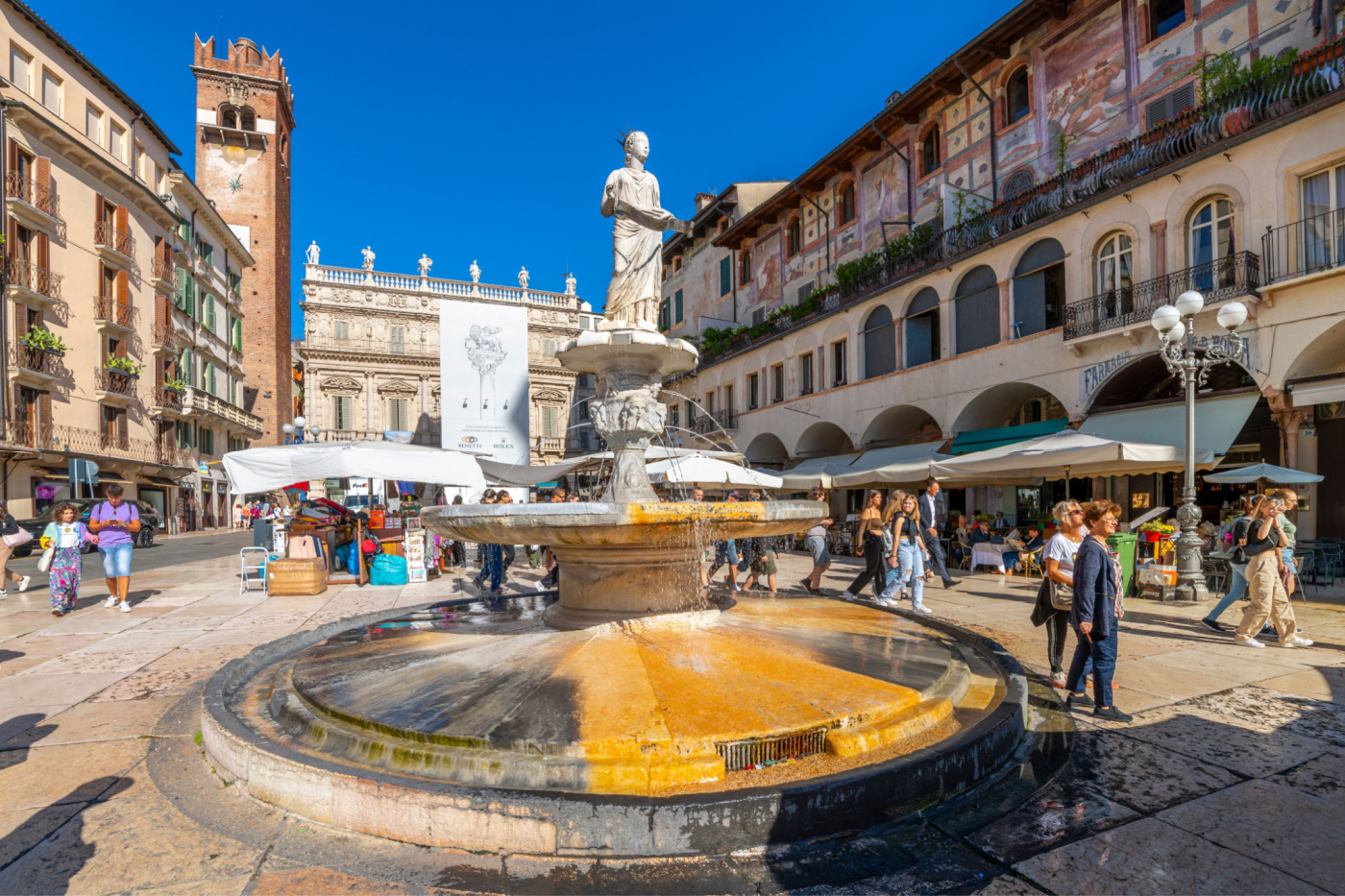
Where to Stay in Verona
Located in a gorgeous 17th-century building, B&B al 19 is like a pensione straight out of E. M. Forster’s Room with a View – except with more modern furnishings and amenities. Each room or suite is color-coordinated throughout and comes with a simple continental breakfast of cold cuts, spreads, and coffee. Incredibly convenient for sightseeing, it’s less than 10 minutes from both the Piazza delle Erbe and Verona Arena.
If you want to get even closer to the Verona Arena, the Romantic Verona is a collection of apartments just down the road from the Roman relic. Designed with couples in mind, each room includes a kitchenette with a fridge, microwave, and kettle, a small seating area with a flat-screen TV, and (our favorite addition) a hot tub where you can decompress at the end of the day. All of these features are in the main area, while a smaller separate room contains the shower, toilet, and washstand.
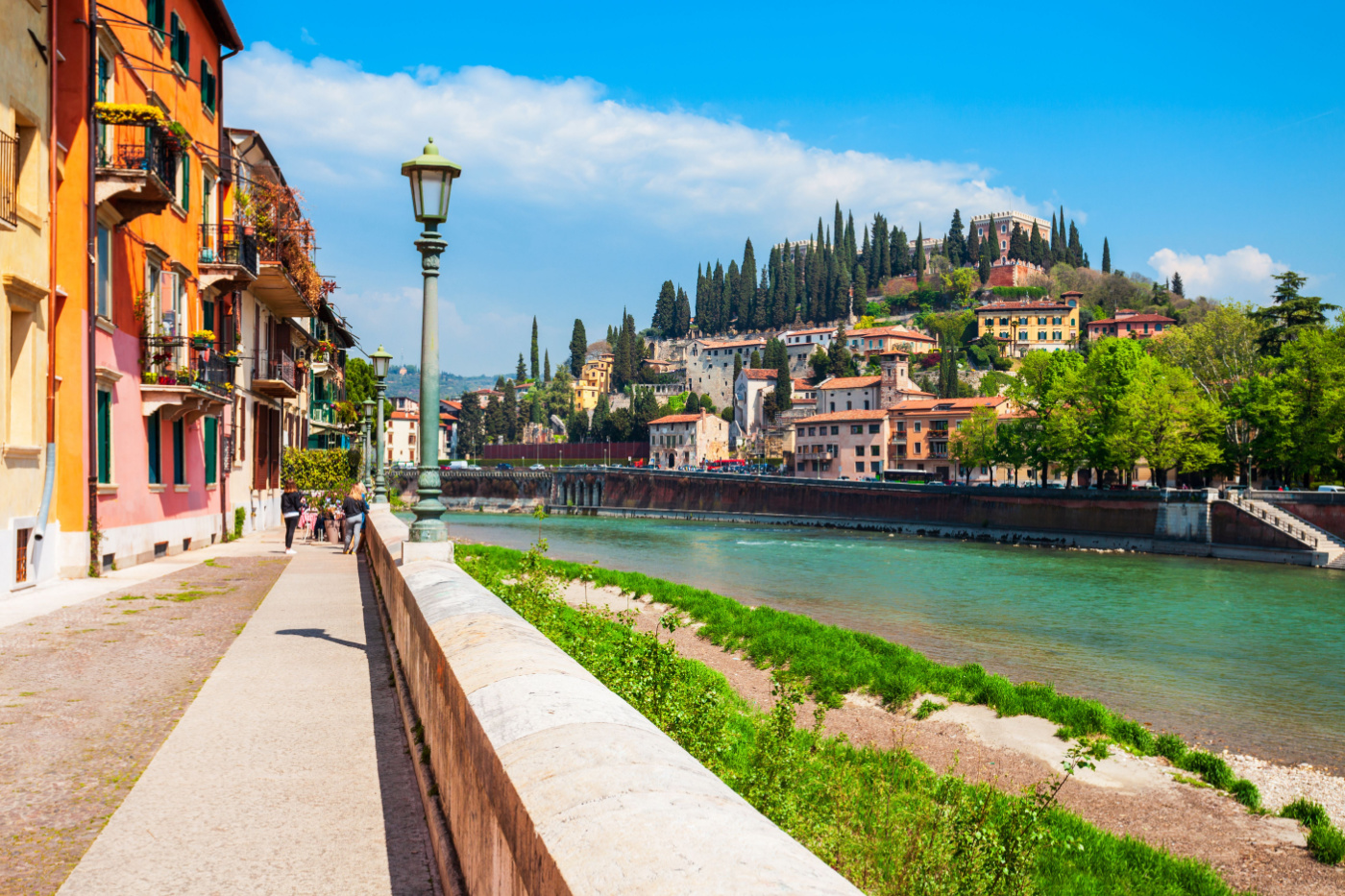
The Best Time of Year to Visit Verona
Overall, the best time of year to visit Verona in our opinion is June or September, when you’ll have a nice balance of sunny, mostly rainless days without the full brunt of the tourist high season. Think average temperatures of around 68 degrees Fahrenheit (20 degrees Celsius).
Having said that, the hottest time of the year in Verona is a perfectly decent temperature for city explorations, and definitely the best time to take advantage of some swimming in a local lake outside the city. For hardcore sunseekers, July and August average a balmy 77 degrees Fahrenheit (approximately 25 degrees Celsius), with peaks of 86 degrees Fahrenheit (30 degrees Celsius). That’s good enough to get you a glorious golden tan.
July also has some of the least rainfall in the city. Only December and January are drier, though they’re also the coldest month, with a chilly average temperature of 37 degrees Fahrenheit (3 degrees Celsius).
If you can, time your visit to coincide with Verona’s opera festival, which takes place every year over the summer. Not only is it one of the city’s most famous cultural treasures, but it’s also one of the most cherished opera events anywhere in the world. Even if you’re not a big opera fan, it’s worth buying some cheap seats to a dramatic work like Aida or Carmen, just so you can sit on the ancient stone seats and hear the powerful voices of the singers fill a space capable of containing 15,000 people. Just remember to bring something to sit on if you have a delicate bum – even the Ancient Romans must have used cushioning of some sort!
How to Get Around Verona
All of the main attractions are within at most half an hour’s walking distance of one another. In other words, it’s easiest to just cross the city on foot. There is a very efficient public bus system, but it’s only very marginally useful for tourists since the routes are predominantly designed for people coming in from the outskirts of town.
Instead, if you don’t want to do more walking then you can help, the city does have a branch of the Hop-On, Hop-Off bus company that covers all the main attractions.




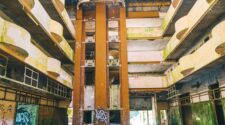

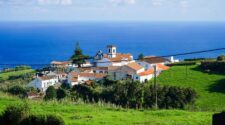
No Comment